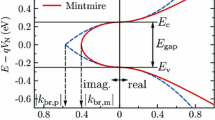Abstract
The scaling-down of devices to the atomistic scale lets them operate close to their ballistic limit. At these dimensions the resistance of the entire system is dominated by the contacts. In this paper we describe a simulation tool by which the metal-nanotube heterostructure is modeled atomistically in its entirety, so that contact properties and the associated contact resistances can be explored for different contact materials. We show results for a self-consistently calculated current-voltage (I-V) for an armchair tube with its open ends contacted to gold-[111] surface.
Similar content being viewed by others
References
D. Mann et al., “Ballistic Transport in Metallic Nanotubes with Reliable Pd Ohmic Contacts,” NanoLett, 3(11), 1541 (2003).
J.N. Murrell and A.J. Harget, Semi-Empirical Self-Consistent-Field Molecular Orbital Theory of Molecules (Wiley-Interscience: New York, 1972).
J. Cerda and F. Soria, “Accurate and transferable extended Hückel-type tight-binding parameters,” Phys. Rev. B, 61(12), 7965 (2000).
J.A. Pople, D.P. Santry, and G.A. Segal, “Approximate Self-Consistent Molecular Orbital Theory I: Invariant Procedure,” J. Chem. Phys., 43(10), 129 (1965).
L.V. Keldysh, “Diagram Technique for Non-Equilibrium Processes,” Sov. Phys. JETP, 20(4), 1018 (1965).
H. Haug and A.P. Jauho, Quantum Kinetics in Transport and Optics of Semiconductors, (Springer: Berlin, 1996).
S. Datta, Electronic Transport In Mesoscopic Systems, (Cambridge University Press: New York, 1995).
P. Damle, A. Ghosh, and S. Datta, “First-principles analysis of molecular conduction using quantum chemsitry software,” Chem. Phys., 281, 171 (2002).
D. Papaconstantopoulos, Handbook of the Bandstructure of Elemental Solids (Plenum Press: New York, 1986).
H.J. Choi et al., “Possible explanation for the conductance of a single quantum unit in metallic carbon nanotubes,” Phys. Rev B, 60(20), 14009 (1999).
J.J. Palacios et al., “First principles Phase-Coherent Transport in Metallic nanotubes with Realistic Contacts,” Phys. Rev. Lett., 90(10), 106801 (2003).
Author information
Authors and Affiliations
Corresponding author
Rights and permissions
About this article
Cite this article
Kienle, D., Ghosh, A.W. Atomistic Modeling of Metal-Nanotube Contacts. J Comput Electron 4, 97–100 (2005). https://doi.org/10.1007/s10825-005-7116-7
Issue Date:
DOI: https://doi.org/10.1007/s10825-005-7116-7




